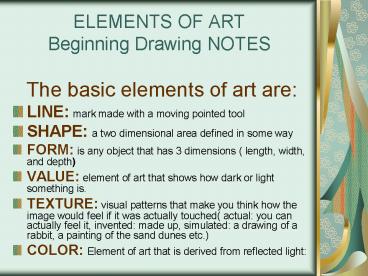ELEMENTS OF ART Beginning Drawing NOTES - PowerPoint PPT Presentation
Title:
ELEMENTS OF ART Beginning Drawing NOTES
Description:
ELEMENTS OF ART Beginning Drawing ... layering values TINT: ... a window-like gadget that helps select an interesting composition by zooming in or out. COLOR: ... – PowerPoint PPT presentation
Number of Views:97
Avg rating:3.0/5.0
Title: ELEMENTS OF ART Beginning Drawing NOTES
1
ELEMENTS OF ARTBeginning Drawing NOTES
- The basic elements of art are
- LINE mark made with a moving pointed tool
- SHAPE a two dimensional area defined in some way
- FORM is any object that has 3 dimensions (
length, width, and depth) - VALUE element of art that shows how dark or
light something is. - TEXTURE visual patterns that make you think how
the image would feel if it was actually touched(
actual you can actually feel it, invented made
up, simulated a drawing of a rabbit, a painting
of the sand dunes etc.) - COLOR Element of art that is derived from
reflected light
2
LINE
- There are 5 basic types of lines-gt Vertical(
static, elegant , stiff), horizontal(calm, peace,
relaxation), diagonal(motion, unstable), curved(
feminine, elegance, softness, gradual motion) and
zigzag( crazy, chaotic, unpredictable, sudden
movement). - There are other lines often used in the process
of learning how to draw - Implied series of dots that the viewer connects
- Outline show only the outside line of an object
- CALLIGRAPHY beautiful handwriting. Lines that
go from thick to thin or thin to thick in one
stroke - Contour show the outline and some surface and
ridges around the object. - Gesture drawn quickly , there are no details,
usually used in timed activities and generally
shows movement.
3
PRINCIPLES OF DESIGNThe choice or arrangement
of elements of art in an artwork
- BALANCE concerned with equalizing
elements/forces/objects in art. It can be
informal or formal ( asymmetrical/symmetrical and
radial ) Balanced work looks like the elements
are arranged in a satisfying way. - CONTRAST ability to create a focal point by
using differences in elements - EMPHASIS principle of art that makes one part of
a work more dominant over the other - MOVEMENT created by the look and feel of action
and to guide the viewers eyes throughout the
work of art - PATTERN decorative and visual repetition
- RHYTHM Its created by repeating positive
shapes, separated by negative shapes/spaces.
Indicates MOVEMENT by REPETITION - UNITY the quality of wholeness or oneness
that is achieved through the effective use of the
elements and principles of art. Unity is created
by simplicity, repetition and proximity - PROPORTION Concerned with the size relationships
of one part to another. - HARMONY Creates unity by stressing the
similarities of separate but related parts. - VARIETY differences, and contrasts, making
everything NOT the same
4
SHAPE
- Two dimensional area defined in some way
- Free-form irregular and uneven
- Geometric can be defined using a math formula
- Organic those created by or found in nature.
- Positive space/shape The object itself
- Negative space/shape the shapes or spaces around
the item being drawn
5
FORM
- 3Dimensional object ( length, width, and depth)
- In visual arts a drawing of a 3Dimensional object
can be obtained by using various shading
technique to create a range of values. - VALUE how dark or light something is.
- VALUE CHART organized arrangement of lights to
dark or dark to light - SHADING TECHINQUES HATCHING (small diagonal
parallel lies, layering and overlapping),
crosshatching( Same as hatching but criss
crossing the direction of the lines),
stippling/pointillism (little dots applied in
layers, somewhat randomly placed), blending
(applying layers of values, and smoothing them
with blending utensils) SCRIBBLING shading with
scribbles, layering values - TINT when you combine White and a color ALWAYS
adding the color TO the white - SHADE color combined with black
6
STILL LIFE
- COMPOSITION the way an artist arranges the items
in their art work - Thumbnail sketches small sketches with different
views to help select a final composition - View finder a window-like gadget that helps
select an interesting composition by zooming in
or out.
7
COLOR Element of art that is derived from
reflected light
- HUE the NAME of a color in the color wheel
- PRIMARY COLORS red, yellow, blue
- SECONDARY you create them by mixing 2 primary
colors ( RYO, BYG, BRV) - TERTIARY Adding more of one of the primary
colors to an already mixed secondary ( RedViolet,
RedOrange, YellowGreen, YellowOrange, etc) - COLOR Element of art that is derived from
reflected
8
COLOR cont.
- TINT when you combine color and white. You MUST
always add color TO the white. - TONE When you add black and white
- ( gray) to a color
- SHADE When you combine a color with black.
(black can be overpowering so use a little amount
at once) - PRIMARY, SECONDARY, TERTIARY add up to how many
colors are there in the color wheel?































